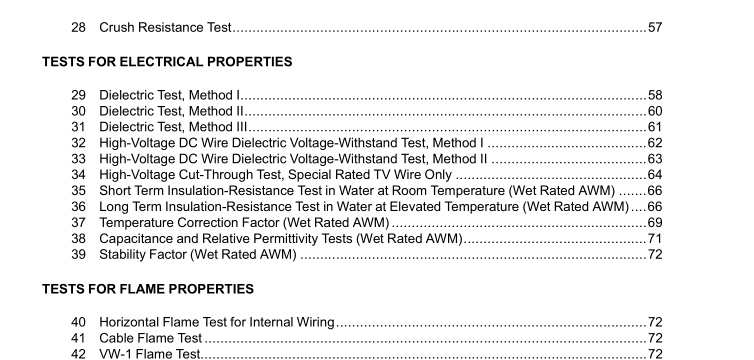UL 758-2019 pdf download.Appliance Wiring Material.
5 Conductor 5.1 General 5.1.1 A conductor consisting of a single wire is designated as a solid conductor, while one consisting of a number of individual wires is designated as a stranded conductor. The American Wire Gauge (AWG) numbers, the kcmil (thousands of circular mils) sizes, and the square-millimeter sizes each signify a definite nominal total cross-sectional area (see Table 5.1 or Table 5.2) independent of the conductor material. The individual wires used in making up a stranded conductor are not required to correspond to any particular AWG or other standard gauge size. A tinsel conductor consists of a number of strands, twisted together, a portion of, or all strands being composed of one or more flattened wires of copper or copper alloy, helically wound on a fibrous polymeric thread. A conductor with a tubular cross-section and uniform wall thickness shall be of copper, and may be metal coated. A bus bar conductor consists of a single bar, or two or more bars stacked to form two or more layers, with each bar of solid rectangular cross-section with two plane, parallel surfaces and round or other simple regularly shaped edges. Fibrous yarns impregnated or coated with metal or other conductive materials may be used as a conductor, or may be assembled with other types of conductor strands to form a conductor. A carbon fiber filament conductor consists of a number of carbon fibers twisted together to form the conductor and the carbon fibers may be metal coated. A resistance wire is a conductor material used in products primarily as the source of heat based on a designed resistance per finished unit length. A magnet wire conductor shall consist of an enameled single conductor or an assembly of individually enameled wires which may be assembled or twisted together with an overall covering of film fiber, tape, or extruded compound to form a Litz wire.
5.4 Metal coating 5.4.1 When the insulation or other materials such as a fibrous thread or a separator adjacent to a copper, copper alloy, copper-clad aluminum, or copper-clad steel conductor is of a material that corrodes unprotected copper as determined in the test in Conductor Corrosion – General, Section 500, of UL 1581, and when a protective separator that prevents the corrosion of the copper conductor material is not provided, the solid conductor and each of the individual strands of a stranded conductor shall be separately covered with a metal or alloy coating complying with 4.1 as applicable to the finished wire. 5.4.2 In the case of a stranded conductor on which a coating is not required for corrosion protection and is solely to keep the insulation from adhering to copper, it is not prohibited to coat only the wires of the outer layer. 5.5 Joints 5.5.1 A joint (splice) in a solid conductor or in one of the individual wires of a stranded conductor shall not change the diameter of the solid conductor, the individual wire strand, or the overall stranded conductor. In other than flexing applications, a joint may be made in a stranded conductor as a whole or may be made by joining each individual wire. For flexing applications, joints shall be made by separately joining each individual strand. A joint shall be made only before any coverings are applied to an insulated conductor. The insulation applied to such joints shall be equivalent to that removed and shall comply with the requirements in this Standard. A joint in a compact or compressed-stranded conductor shall be made before compacting or compressing. 5.5.2 In a rope-lay-stranded conductor which consists of a central core surrounded by one or more layers of stranded members (primary groups), each member shall be spliced as a unit. These splices are not to be any closer together than two lay lengths.UL 758-2019 pdf download.
UL 758-2019 pdf download
